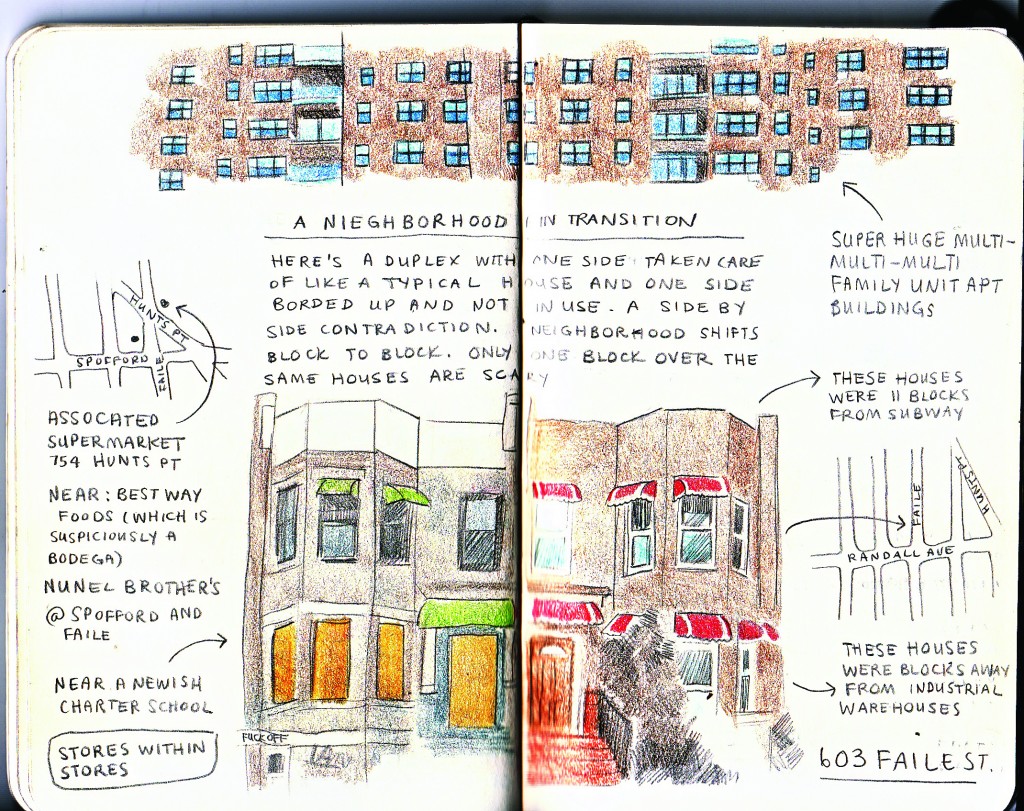Hunches and Wanderings
Posted on April 21, 2011 | posted by:The neighborhood of Hunts Point in the South Bronx serves as our subject of external observation and dialectical practice. It becomes a laboratory for a collection of curious and ambitious transdisciplinary design graduate students. In the classroom, we are prepped in a multitude of ways around our main topic of interest: food consumption, production, and distribution in one of the statistically poorest congressional districts of the United States. As we collect data from our wanderings, through our cameras and collages of trash gathered from the frozen snow, our focus begins to sharpen. We settle on investigating the ecological frameworks explicit in the environment, the spaces and environments that people practice out their lives.
Our initial hunch about the urban planning of Hunts Point was inspired by Jane Jacobs manifesto in regards to sidewalks as a conduit for communication in urban environments. We asked ourselves how might an objective environment develop a resident’s sense of autonomy? We populated a map locating specific areas of use from schools to retail and correctional facilities to green space. Clusters began to form around residential and industrial areas reflecting the effect of strict zoning regulations. The physical environment adheres very seriously to a set of rules determining relative sizes of buildings and planning their use. In short, kitchens are regulated. The square footage, the shelving space, and the amenities are prescribed. Green space is the next on the list of hot areas to re-envision and control experience. The vision plan for Hunts Point into the future remembers the coast and the importance of trees as co-residents of an urban ecosystem. The future of Hunts Point shifts its focus from the inside, where it has spent the last few decades a la public housing, to the outside where various interested parties play with the development of the “third space”. But before we join in the chorus of praise of new parks and bike lanes, let’s take a bit of a closer look at the subsidies that evolved and creates the places that we known as public housing.
Public Housing in NYC exists as a dream for many who arrive in the city unable to cope with the high cost of living. Few people are able to afford a view of Central Park. NYC is not a city of few. It is a city of over eight million people. Our hunch speculated that subsidies were the currency of Hunts Point. Our research dually indicates a strong financial incentive for landlords and residents to maintain the current balance of low income housing and rent subsidies. This combined with the food insecurity, results in an incentive system of housing and food subsidies that in turn support and determine the housing and business stock of the neighborhood. Large multi-floor efficient apartment buildings persist. Located conveniently, almost symbiotically on corners, are clusters of bodegas offering a variety of goods from sodas to WIC and EBT sanctioned items. Few restaurants dare to exist in the neighborhood, save for ones that offer cheap food available for delivery. The system of reinforcing incentives, both in housing and food subsidies, creates a static environment that in its current configuration results in food related health issues. These issues are very visible both in our research and the media. But we begin to become curious, almost skeptical as to why. This quizzically drives us deeper as we launch our next chapter into field work.
Armed with a native Spanish speaker, a loyal documentarian and a quick-draw illustrator we enter into a conversation with locals. Tired of our own presumptions about the interior cooking and storage spaces we look to residents for new perspective. We revisit out hunch: you are what you eat. Our field research revealed strong community ties amongst regional cooking styles, ritual, culture, language, and gender roles. Talking to both men and women of a similar generational background we piece together a framework of a community where older matriarchal figures cook traditional fare in shared living situation that may or may not be distributed to a wide range of individuals with similar regional tastes. This family, more based on culture rather than blood ties, creates and impromptu network of food distribution. So much so that many individuals acquire additional storage in the form of a mini-fridge for their bedroom. The roles between men and women that seem explicit amongst the older set are broken and rejected amongst those younger. These women reject traditional roles in an effort to assimilate into perceived American culture, trying to emulate ideals of independence and freedom and adopting ubiquitous new york take-out. This last foray leaves us with the insight into the reality here is that it is not about food access, or shaped by the environment, or physical construction, or the objective environment, but by a subjective desire to become something or an identity.
Finally we are again back to where we started. A question had been rolling around in our heads from the beginning: can we transform an individual’s voice from passive to active? What does it mean to be an immigrant in a country if immigrants? And how can we better understand how people separated from families and cultures connect in other social ways? What are the implications of this in Hunts Point? All of these questions are grounded in an exploration of the landscape of policy and subsidy. But that isn’t the only facet. We begin to internalize these problems in a way that designer must to synthesize a conversation. In the next few weeks, we will begin to crack that open a bit more and discover what we are really trying to say.
